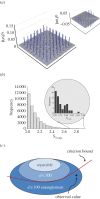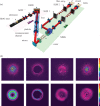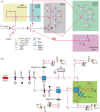Orbital angular momentum of photons and the entanglement of Laguerre-Gaussian modes
- PMID: 28069773
- PMCID: PMC5247486
- DOI: 10.1098/rsta.2015.0442
Orbital angular momentum of photons and the entanglement of Laguerre-Gaussian modes
Abstract
The identification of orbital angular momentum (OAM) as a fundamental property of a beam of light nearly 25 years ago has led to an extensive body of research around this topic. The possibility that single photons can carry OAM has made this degree of freedom an ideal candidate for the investigation of complex quantum phenomena and their applications. Research in this direction has ranged from experiments on complex forms of quantum entanglement to the interaction between light and quantum states of matter. Furthermore, the use of OAM in quantum information has generated a lot of excitement, as it allows for encoding large amounts of information on a single photon. Here, we explain the intuition that led to the first quantum experiment with OAM 15 years ago. We continue by reviewing some key experiments investigating fundamental questions on photonic OAM and the first steps to applying these properties in novel quantum protocols. At the end, we identify several interesting open questions that could form the subject of future investigations with OAM.This article is part of the themed issue 'Optical orbital angular momentum'.
Keywords: Laguerre–Gaussian modes; high-dimensional Hilbert space; orbital angular momentum; photonic quantum experiments.
© 2017 The Author(s).
Figures







References
-
- Arlt J, Dholakia K, Allen L, Padgett MJ. 1999. Parametric down-conversion for light beams possessing orbital angular momentum. Phys. Rev. A 59, 3950–3952. (10.1103/PhysRevA.59.3950) - DOI
-
- Mair A. 2000. Nichtlokale und Singuläre Quantenzustände des Lichts. PhD thesis, University of Vienna, Austria.
-
- Torres JP, Alexandrescu A, Torner L. 2003. Quantum spiral bandwidth of entangled two-photon states. Phys. Rev. A 68, 050301 (10.1103/PhysRevA.68.050301) - DOI
Publication types
LinkOut - more resources
Full Text Sources
Other Literature Sources
